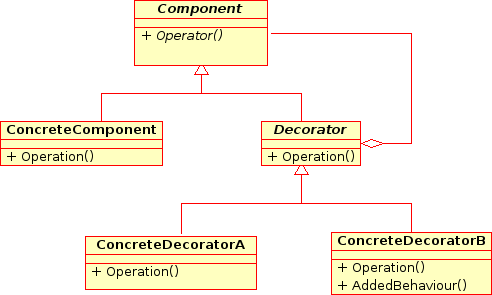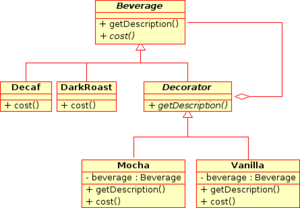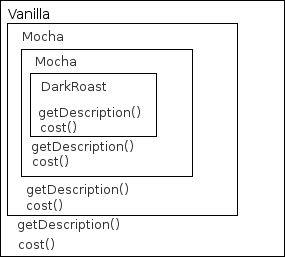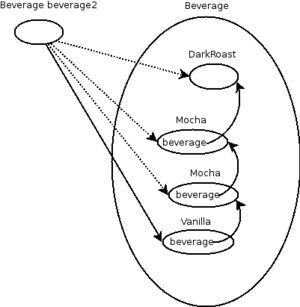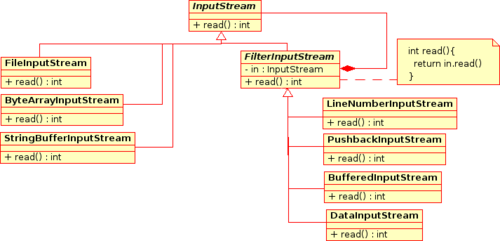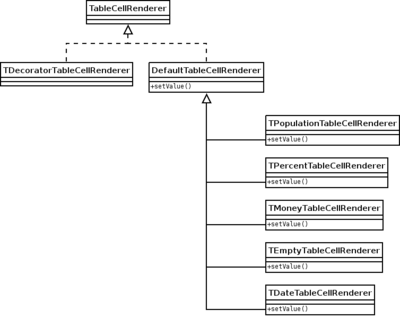Difference between revisions of "Decorator"
m (→Example) |
|||
| (40 intermediate revisions by the same user not shown) | |||
| Line 1: | Line 1: | ||
| + | [[BTP600]] > [[Decorator]] | ||
| + | |||
Allow new/additional responsibility to be added to an existing object dynamically. Decoratores provide a flexible alternative to subclassing for extending functionality. | Allow new/additional responsibility to be added to an existing object dynamically. Decoratores provide a flexible alternative to subclassing for extending functionality. | ||
| Line 4: | Line 6: | ||
==Introduction== | ==Introduction== | ||
| − | + | Decorator, a [http://en.wikipedia.org/wiki/Structural_pattern structual pattern] also known as wrapper, adds additional functionality to a class at runtime through composition. Decorators are alternative to subclassing which add behaviour at compile time. By wrapping, it allows us to add things to the component without requiring every subclass to inherit these new qualities. Each decorator class wraps a component, which means the decorator has an instance variable that holds a reference to a component. | |
| − | |||
| − | |||
| − | |||
| − | |||
| − | |||
==Motivation== | ==Motivation== | ||
| + | As an example we can look at a coffee shop ordering service where beverages can be decorated with different kinds of condiments. By using the Decorator pattern one can get their beverage just right and the cost can be easily calculated for every added condiment. Adding new beverages/condiments is easy too, just by creating the new class and changing the menu. | ||
==Sample Code== | ==Sample Code== | ||
| − | + | [[Image:beveragedecorator.png|300 px|thumb|Beverage Decorator UML diagram]] | |
| + | Beverage is the abstract component class | ||
| + | public abstract class Beverage { | ||
| + | String description = "Unknown Beverage"; | ||
| + | |||
| + | public String getDescription() { | ||
| + | return description; | ||
| + | } | ||
| + | |||
| + | public abstract double cost(); | ||
| + | //static abstract double size(); | ||
| + | } | ||
| + | |||
| + | [[Image:wrappingdecorator2.png|300 px|thumb|Figure 1 wrapping Decorator classes]] | ||
| − | + | Leaf classes that inherit from Beverage class | |
| − | + | public class DarkRoast extends Beverage { | |
| − | public | + | public DarkRoast() { |
| − | public | + | description = "Dark Roast Coffee"; |
| + | } | ||
| + | |||
| + | public double cost() { | ||
| + | return .99; | ||
| + | } | ||
} | } | ||
| − | + | ||
| − | + | public class Decaf extends Beverage { | |
| − | class | + | public Decaf() { |
| − | public | + | description = "Decaf Coffee"; |
| − | |||
} | } | ||
| − | public | + | public double cost() { |
| − | + | return 1.05; | |
} | } | ||
} | } | ||
| − | The | + | [[Image:beverageDecoratorWholePic.png|300 px|thumb|The Big Picture]] |
| + | |||
| + | Condiment Decorator class | ||
| + | public abstract class CondimentDecorator extends Beverage { | ||
| + | public abstract String getDescription(); | ||
| + | } | ||
| − | + | Mocha is a concrete decorator class that implements cost() and getDescription() | |
| − | + | public class Mocha extends CondimentDecorator { | |
| − | + | Beverage beverage; | |
| − | public | + | public Mocha(Beverage beverage) { |
| − | + | this.beverage = beverage; | |
} | } | ||
| − | |||
| − | + | public String getDescription() { | |
| − | + | return beverage.getDescription() + ", Mocha"; | |
| − | public | ||
| − | |||
} | } | ||
| − | + | ||
| − | public | + | public double cost() { |
| − | + | return 0.10 + beverage.cost(); | |
| − | |||
} | } | ||
| + | } | ||
| + | |||
| + | Another concrete decorator | ||
| + | public class Vanilla extends CondimentDecorator { | ||
| + | Beverage beverage; | ||
| − | + | public Vanilla(Beverage beverage) { | |
| − | + | this.beverage = beverage; | |
} | } | ||
public String getDescription() { | public String getDescription() { | ||
| − | + | return beverage.getDescription() + ", Vanilla"; | |
} | } | ||
| − | |||
| − | + | public double cost() { | |
| − | + | return 0.20 + beverage.cost(); | |
| − | public | ||
| − | |||
} | } | ||
| + | } | ||
| + | |||
| + | The main: Here we are creating a new Decaf object with no condiments and printing its description and cost. | ||
| + | The second beverage is created and we call it DarkRoast, we add two shots of Mocha and a shot of vanilla. | ||
| + | Note how the beverage object is passed into the condiment decorator, this is how wrapping works. | ||
| + | DarkRoast is wrapped with Mocha first, the Mocha object stores a reference to the beverage passed in. | ||
| + | This is demonstrated in Figure 1. | ||
| + | public class StarbuzzCoffee { | ||
| + | public static void main(String args[]) { | ||
| + | Beverage beverage = new Decaf(); | ||
| + | System.out.println(beverage.getDescription() + " $" + beverage.cost()); | ||
| − | + | Beverage beverage2 = new DarkRoast(); | |
| − | + | beverage2 = new Mocha(beverage2); | |
| − | + | beverage2 = new Mocha(beverage2); | |
| + | beverage2 = new Vanilla(beverage2); | ||
| + | System.out.println(beverage2.getDescription() + " $" + beverage2.cost()); | ||
} | } | ||
| + | } | ||
| + | <!-- | ||
| + | {| align="left" | ||
| + | |- | ||
| + | [[Image:beveragedecorator.png|300 px|Beverage Decorator UML diagram]] | ||
| + | [[Image:wrappingdecorator.png|300 px|Figure 1 wrapping Decorator classes]] | ||
| + | [[Image:beverageDecoratorWholePic.png|300 px|Whole Picture]] | ||
| + | |} | ||
| + | --> | ||
| + | |||
| + | ==Example== | ||
| + | [[Image:javaIOdecorator2.png|500 px|thumb|Java I/O classes]] | ||
| + | |||
| + | Java I/O [http://java.sun.com/javase/6/docs/api/java/io/package-frame.html API] | ||
| + | |||
| + | JDK 6u1 [http://www.java.net/download/jdk6/6u1/promoted/b03/jdk-6u1-ea-src-b03-jrl-19_jan_2007.jar Source] under the [http://www.java.net/jrl.csp JRL license] | ||
| + | |||
| + | extract: java -jar jdk-6u1-ea-src-b03-jrl-19_jan_2007.jar | ||
| + | |||
| + | java.io location: j2se/src/share/classes/java/io/ | ||
| + | |||
| + | ---- | ||
| + | Abstract Component class: | ||
| + | public abstract class InputStream { | ||
| + | abstract int read(); | ||
| − | + | } | |
| − | // | + | Concrete Component class: |
| + | class FileInputStream extends InputStream | ||
| + | { | ||
| + | public int read(); | ||
| + | } | ||
| + | Decorator class: | ||
| + | public | ||
| + | class FilterInputStream extends InputStream { | ||
| + | { | ||
| + | //<span style="color:red">Local variable for storing the reference of the concrete component class</span> | ||
| + | protected volatile InputStream in; | ||
| + | |||
| + | protected FilterInputStream(InputStream in) { | ||
| + | this.in = in; | ||
| + | } | ||
| + | |||
| + | public int read() { | ||
| + | return in.read(); | ||
| + | } | ||
| + | } | ||
| + | Concrete Decorator class: | ||
| + | public | ||
| + | class PushbackInputStream extends FilterInputStream { | ||
| + | public PushbackInputStream(InputStream in, int size) { | ||
| + | super(in); //<span style="color:red">Calls the FilterInputStream class and stores the reference of InputStream</span> | ||
| + | if (size <= 0) { | ||
| + | throw new IllegalArgumentException("size <= 0"); | ||
| + | } | ||
| + | this.buf = new byte[size]; | ||
| + | this.pos = size; | ||
} | } | ||
| − | public | + | public int read(){ |
| − | return | + | ensureOpen(); |
| + | if (pos < buf.length) { | ||
| + | return buf[pos++] & 0xff; | ||
| + | } | ||
| + | return super.read(); | ||
} | } | ||
} | } | ||
| − | + | ---- | |
| − | public class | + | |
| − | + | [[Image:mpclDecorator.png|400 px|thumb|MPCL]] | |
| − | + | ||
| − | + | Multi purpose class library (MPCL) | |
| − | + | ||
| + | [http://www.google.com/codesearch?hl=en&q=show:QUdC7Hs10WU:9dcfaUrTzRs:gcPYjQUkI_I&sa=N&ct=rd&cs_p=http://www.uesqlc.org/download/mpcl/mpcl-11.0.2.zip&cs_f=mpcl-11.0.2/src/java/lib/org/mpcl/nui/table/TDecoratorTableCellRenderer.java Source Code] | ||
| + | |||
| + | GPL license | ||
| + | |||
| + | ---- | ||
| + | |||
| + | Concrete Components <br> | ||
| + | TDecoratorTableCellRenderer: | ||
| + | /** | ||
| + | * Table cell renderer that decorates a delegate cell renderer. It implements | ||
| + | * the Decorator design pattern. | ||
| + | */ | ||
| + | public class TDecoratorTableCellRenderer implements TableCellRenderer | ||
| + | { | ||
| + | |||
| + | /// Delegate table cell renderer. | ||
| + | private TableCellRenderer tDelegateTableCellRenderer; | ||
| + | |||
| + | /// Table cell decorator. | ||
| + | private ITableCellDecorator tTableCellDecorator; | ||
| + | |||
| + | |||
| + | // | ||
| + | // C O N S T R U C T O R S | ||
| + | // | ||
| − | // | + | /** |
| − | + | * Builds a new instance. | |
| + | * @param tDELEGATE_TABLE_CELL_RENDERER The delegate table cell renderer. | ||
| + | * @param tTABLE_CELL_DECORATOR Table cell decorator. | ||
| + | */ | ||
| + | public TDecoratorTableCellRenderer ( TableCellRenderer tDELEGATE_TABLE_CELL_RENDERER , | ||
| + | ITableCellDecorator tTABLE_CELL_DECORATOR ) | ||
| + | { | ||
| + | tDelegateTableCellRenderer = tDELEGATE_TABLE_CELL_RENDERER; | ||
| + | tTableCellDecorator = tTABLE_CELL_DECORATOR; | ||
| + | } | ||
| + | |||
| + | |||
| + | DefaultTableCellRenderer: | ||
| + | public class DefaultTableCellRenderer extends JLabel | ||
| + | implements TableCellRenderer, Serializable | ||
| + | { | ||
| + | /** | ||
| + | * Creates a default table cell renderer. | ||
| + | */ | ||
| + | public DefaultTableCellRenderer() { | ||
| + | super(); | ||
| + | setOpaque(true); | ||
| + | setBorder(getNoFocusBorder()); | ||
} | } | ||
} | } | ||
| − | == | + | TDateTableCellRenderer: |
| − | + | public class TDateTableCellRenderer extends DefaultTableCellRenderer | |
| − | + | { | |
| + | /// Date format. | ||
| + | private DateFormat tDateFormat; | ||
| + | |||
| + | // | ||
| + | // C O N S T R U C T O R S | ||
| + | // | ||
| + | |||
| + | /** | ||
| + | * Sets the String object for the cell being rendered to value. | ||
| + | * @param tVALUE The value for this cell; if \a tVALUE is \a null it sets the | ||
| + | * the text value to an empty string. | ||
| + | * @see javax.swing.table.DefaultTableCellRenderer#setValue() | ||
| + | */ | ||
| + | protected void setValue (Object tVALUE) | ||
| + | { | ||
| + | setText (( tVALUE == null ) ? "" : tDateFormat.format ((Date) tVALUE)); | ||
| + | } | ||
| + | |||
| + | TPopulationTableCellRenderer: | ||
| + | /// Table cell renderer for \a TPopulation objects. | ||
| + | public class TPopulationTableCellRenderer extends DefaultTableCellRenderer | ||
| + | { | ||
| + | |||
| + | /// Number format. | ||
| + | public NumberFormat tNumberFormat; | ||
| + | |||
| + | // | ||
| + | // C O N S T R U C T O R S | ||
| + | // | ||
| + | |||
| + | /** | ||
| + | * Sets the String object for the cell being rendered to value. | ||
| + | * @param tVALUE The value for this cell; if \a tVALUE is \a null it sets the | ||
| + | * the text value to an empty string. | ||
| + | * @see javax.swing.table.DefaultTableCellRenderer#setValue() | ||
| + | */ | ||
| + | protected void setValue (Object tVALUE) | ||
| + | { | ||
| + | if ( tNumberFormat == null) | ||
| + | { | ||
| + | tNumberFormat = TDecimalFormat._getPopulationInstance(); | ||
| + | } | ||
| + | setText (( tVALUE == null ) ? "" : tNumberFormat.format (((TPopulation) tVALUE).intValue())); | ||
| + | } | ||
| + | |||
| + | // | ||
| + | // C O N S T R U C T O R S | ||
| + | // | ||
| + | |||
| + | /// Builds a new instance. | ||
| + | public TPopulationTableCellRenderer() | ||
| + | { | ||
| + | super(); | ||
| + | setHorizontalAlignment (DefaultTableCellRenderer.RIGHT); | ||
| + | } | ||
| + | |||
| + | } // class TPopulationTableCellRenderer | ||
| + | |||
| + | ==Contributions== | ||
| + | [http://zenit.senecac.on.ca/wiki/index.php/Talk:Adapter Adapter pattern] in Eclipse | ||
==References== | ==References== | ||
Gamma, Erich; Helm, Richard; Johnson, Ralph; Vlissides, John (1994). Design Patterns: Elements of Reusable Object-Oriented Software. Addison-Wesley. ISBN 0-201-63361-2. | Gamma, Erich; Helm, Richard; Johnson, Ralph; Vlissides, John (1994). Design Patterns: Elements of Reusable Object-Oriented Software. Addison-Wesley. ISBN 0-201-63361-2. | ||
| + | |||
| + | Freeman, Eric; Freeman, Elisabeth; Sierra, Kathy; Bates, Bert (2004). Head First Design Patterns. O`Reilly. ISBN 0-596-00712-4. | ||
| + | |||
http://www.dofactory.com/Patterns/PatternDecorator.aspx | http://www.dofactory.com/Patterns/PatternDecorator.aspx | ||
Latest revision as of 13:33, 11 April 2007
Allow new/additional responsibility to be added to an existing object dynamically. Decoratores provide a flexible alternative to subclassing for extending functionality.
Introduction
Decorator, a structual pattern also known as wrapper, adds additional functionality to a class at runtime through composition. Decorators are alternative to subclassing which add behaviour at compile time. By wrapping, it allows us to add things to the component without requiring every subclass to inherit these new qualities. Each decorator class wraps a component, which means the decorator has an instance variable that holds a reference to a component.
Motivation
As an example we can look at a coffee shop ordering service where beverages can be decorated with different kinds of condiments. By using the Decorator pattern one can get their beverage just right and the cost can be easily calculated for every added condiment. Adding new beverages/condiments is easy too, just by creating the new class and changing the menu.
Sample Code
Beverage is the abstract component class
public abstract class Beverage {
String description = "Unknown Beverage";
public String getDescription() {
return description;
}
public abstract double cost();
//static abstract double size();
}
Leaf classes that inherit from Beverage class
public class DarkRoast extends Beverage {
public DarkRoast() {
description = "Dark Roast Coffee";
}
public double cost() {
return .99;
}
}
public class Decaf extends Beverage {
public Decaf() {
description = "Decaf Coffee";
}
public double cost() {
return 1.05;
}
}
Condiment Decorator class
public abstract class CondimentDecorator extends Beverage {
public abstract String getDescription();
}
Mocha is a concrete decorator class that implements cost() and getDescription()
public class Mocha extends CondimentDecorator {
Beverage beverage;
public Mocha(Beverage beverage) {
this.beverage = beverage;
}
public String getDescription() {
return beverage.getDescription() + ", Mocha";
}
public double cost() {
return 0.10 + beverage.cost();
}
}
Another concrete decorator
public class Vanilla extends CondimentDecorator {
Beverage beverage;
public Vanilla(Beverage beverage) {
this.beverage = beverage;
}
public String getDescription() {
return beverage.getDescription() + ", Vanilla";
}
public double cost() {
return 0.20 + beverage.cost();
}
}
The main: Here we are creating a new Decaf object with no condiments and printing its description and cost. The second beverage is created and we call it DarkRoast, we add two shots of Mocha and a shot of vanilla. Note how the beverage object is passed into the condiment decorator, this is how wrapping works. DarkRoast is wrapped with Mocha first, the Mocha object stores a reference to the beverage passed in. This is demonstrated in Figure 1.
public class StarbuzzCoffee {
public static void main(String args[]) {
Beverage beverage = new Decaf();
System.out.println(beverage.getDescription() + " $" + beverage.cost());
Beverage beverage2 = new DarkRoast();
beverage2 = new Mocha(beverage2);
beverage2 = new Mocha(beverage2);
beverage2 = new Vanilla(beverage2);
System.out.println(beverage2.getDescription() + " $" + beverage2.cost());
}
}
Example
Java I/O API
JDK 6u1 Source under the JRL license
extract: java -jar jdk-6u1-ea-src-b03-jrl-19_jan_2007.jar
java.io location: j2se/src/share/classes/java/io/
Abstract Component class:
public abstract class InputStream {
abstract int read();
}
Concrete Component class:
class FileInputStream extends InputStream
{
public int read();
}
Decorator class:
public
class FilterInputStream extends InputStream {
{
//Local variable for storing the reference of the concrete component class
protected volatile InputStream in;
protected FilterInputStream(InputStream in) {
this.in = in;
}
public int read() {
return in.read();
}
}
Concrete Decorator class:
public
class PushbackInputStream extends FilterInputStream {
public PushbackInputStream(InputStream in, int size) {
super(in); //Calls the FilterInputStream class and stores the reference of InputStream
if (size <= 0) {
throw new IllegalArgumentException("size <= 0");
}
this.buf = new byte[size];
this.pos = size;
}
public int read(){
ensureOpen();
if (pos < buf.length) {
return buf[pos++] & 0xff;
}
return super.read();
}
}
Multi purpose class library (MPCL)
GPL license
Concrete Components
TDecoratorTableCellRenderer:
/**
* Table cell renderer that decorates a delegate cell renderer. It implements
* the Decorator design pattern.
*/
public class TDecoratorTableCellRenderer implements TableCellRenderer
{
/// Delegate table cell renderer.
private TableCellRenderer tDelegateTableCellRenderer;
/// Table cell decorator.
private ITableCellDecorator tTableCellDecorator;
//
// C O N S T R U C T O R S
//
/**
* Builds a new instance.
* @param tDELEGATE_TABLE_CELL_RENDERER The delegate table cell renderer.
* @param tTABLE_CELL_DECORATOR Table cell decorator.
*/
public TDecoratorTableCellRenderer ( TableCellRenderer tDELEGATE_TABLE_CELL_RENDERER ,
ITableCellDecorator tTABLE_CELL_DECORATOR )
{
tDelegateTableCellRenderer = tDELEGATE_TABLE_CELL_RENDERER;
tTableCellDecorator = tTABLE_CELL_DECORATOR;
}
DefaultTableCellRenderer:
public class DefaultTableCellRenderer extends JLabel
implements TableCellRenderer, Serializable
{
/**
* Creates a default table cell renderer.
*/
public DefaultTableCellRenderer() {
super();
setOpaque(true);
setBorder(getNoFocusBorder());
}
}
TDateTableCellRenderer:
public class TDateTableCellRenderer extends DefaultTableCellRenderer
{
/// Date format.
private DateFormat tDateFormat;
//
// C O N S T R U C T O R S
//
/**
* Sets the String object for the cell being rendered to value.
* @param tVALUE The value for this cell; if \a tVALUE is \a null it sets the
* the text value to an empty string.
* @see javax.swing.table.DefaultTableCellRenderer#setValue()
*/
protected void setValue (Object tVALUE)
{
setText (( tVALUE == null ) ? "" : tDateFormat.format ((Date) tVALUE));
}
TPopulationTableCellRenderer:
/// Table cell renderer for \a TPopulation objects.
public class TPopulationTableCellRenderer extends DefaultTableCellRenderer
{
/// Number format.
public NumberFormat tNumberFormat;
//
// C O N S T R U C T O R S
//
/**
* Sets the String object for the cell being rendered to value.
* @param tVALUE The value for this cell; if \a tVALUE is \a null it sets the
* the text value to an empty string.
* @see javax.swing.table.DefaultTableCellRenderer#setValue()
*/
protected void setValue (Object tVALUE)
{
if ( tNumberFormat == null)
{
tNumberFormat = TDecimalFormat._getPopulationInstance();
}
setText (( tVALUE == null ) ? "" : tNumberFormat.format (((TPopulation) tVALUE).intValue()));
}
//
// C O N S T R U C T O R S
//
/// Builds a new instance.
public TPopulationTableCellRenderer()
{
super();
setHorizontalAlignment (DefaultTableCellRenderer.RIGHT);
}
} // class TPopulationTableCellRenderer
Contributions
Adapter pattern in Eclipse
References
Gamma, Erich; Helm, Richard; Johnson, Ralph; Vlissides, John (1994). Design Patterns: Elements of Reusable Object-Oriented Software. Addison-Wesley. ISBN 0-201-63361-2.
Freeman, Eric; Freeman, Elisabeth; Sierra, Kathy; Bates, Bert (2004). Head First Design Patterns. O`Reilly. ISBN 0-596-00712-4.
